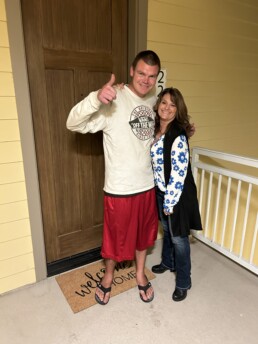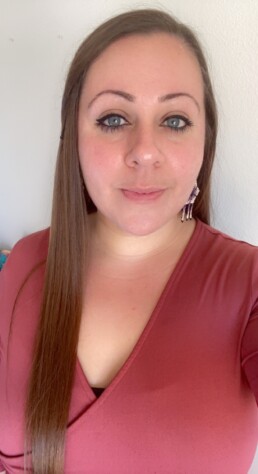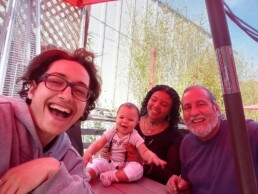The COTS Collective: October 2023

Mission Moment: Kids First Family Shelter:
Providing a Safe Haven for Petaluma Children and Families.
Since 1988, COTS has served our community as one of the largest homelessness services providers in Sonoma County. Many people in Petaluma and the surrounding area know about the COTS Mary Isaak Center—our emergency shelter for unsheltered adults in Petaluma. Fewer people know about the COTS Kids First Family Shelter (KFFS.)
KFFS offers safe and supportive shelter space for families with minors living in Petaluma and the surrounding area. COTS can house up to seven families at KFFS at any given time. In addition to shelter, KFFS also provides supportive services for families including case management, assistance enrolling children into area schools, assistance with establishing a primary care provider and transportation to appointments, and assistance developing meaningful pathways to employment.
Over the last year, KFFS has continued its tireless pursuit of supporting unsheltered families and their children in Petaluma. Over the holidays, COTS provides numerous fun activities and gifts for children and their parents including Halloween costumes, cookie decorating, Christmas gifts, and a Thanksgiving meal.
Unfortunately, KFFS has a long waiting list of families who need our support. While COTS is in awe of the impact our community has on these families, our goal is to be able to support every family in need throughout Sonoma County.
Through the unwavering support and generous contributions of our donors, COTS is able to continue our tradition of serving families who need us most. We invite you to support this incredible program and thank you for your continuing support of our important work. We thank you for your dedication to our mission.
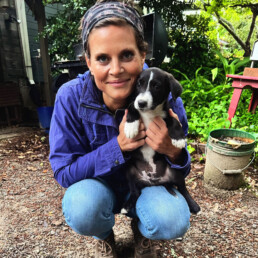
Sincerely,

Chris Cabral, CEO

“That stepping stone that COTS gave us was really, really great, and everything is for the better for it. We finally got ourselves to a point where we can build from, so it’s just up from here. We’re just so appreciative of the opportunities COTS gave us.”
-Brandy, Luna’s mom and former client at Kids First Family Shelter
Lupe's Story
A former COTS' client, single mother of two, and graduate from Sonoma State, Lupe Gonzalez, took time from her busy day to tell us about her story, her time at COTS, and where she is today.
Lupe came here in 2014 with her daughter and started school at Sonoma State. She was able to find a small studio in Santa Rosa and work two jobs: one at Sonoma State and one at the food bank, but she was commuting a lot.
After months of the long commute, she thought, "Okay, this is not working" and began looking for a place to live that would be closer to Sonoma. When she finally found her dream place, she sent all her savings in for a deposit. Unfortunately, it was a scam. "I lost pretty much everything. I learned my lesson from that, but I went through a little meltdown where I was hospitalized." Lupe recalled.
At the time, Lupe was also going through a divorce with her ex-husband who was struggling with his mental health. She held onto hope that the relationship would work out but also wanted to stay away from that situation. "I wanted to be better. I am the first one in my family to go to college. When I started school, I had all these dreams and ambitions." I thought, "I'm going to get it done. And even though I'm a single mom, I’m going to do it!"
After getting scammed and hit by a depressive episode, Lupe and her daughter ended up homeless for three months. Sometimes her daughter was able to stay with a friend, but there was not enough room for both of them. Lupe often had to sleep in her car. During this time, she was able to make things work and shower at Sonoma State until she found a room to rent. Unfortunately, the room was located in Santa Rosa again, which meant her commute would increase. The room was not a safe space for long as the landlady often criticized Lupe's parenting styles and proved to be invasive into their business. Lupe made it work for three months until Sonoma State got her a hotel for a couple of months. This was good, but it was still just temporary.
Through a co-worker of her ex, Lupe was able to find a living room space for rent that would only cost around $300. In this space, Lupe and her daughter were able to sleep safely and had access to the bathroom. Soon after moving in, problems between the current residents there started. This left Lupe and her daughter in the middle of arguments and back in an unsafe environment with less and less space as another person moved into the house. "Living here was not going to work out. We were homeless again, and I was struggling."
While Lupe continued her search for housing and her education, her ex-husband challenged her for full custody of their daughter. "I was worried about doing what was best for my daughter." I thought, “Is she going to be better going with her dad? Is she going to be better with me?” He was not mentally stable, but I was homeless. Seeing her struggle, Lupe's then-boyfriend at the time offered her and her daughter a space to live with him and his family. They moved in and were happy as life progressed. Her daughter was safe, and Lupe and her then-boyfriend were able to get a job at the same location and commute together each day.
With her housing situation seemingly sorted out, Lupe finally won full custody of her daughter and learned she was expecting a second child. Her victory celebration was cut short when a switch flipped in her then-boyfriend, and he became abusive. During her pregnancy, Lupe endured mental, physical, and verbal abuse while trying to protect both of her children. Afraid of losing her family, she went into survival mode.
After her beautiful son was born, she and her then-boyfriend decided to give their relationship one final shot while living on their own in Petaluma. The first year was good, but then her boyfriend quit his job because he was not getting promoted. While he was unemployed, Lupe paid the bills, worked, and cared for her children. Luckily, he was able to find employment again and started working in their apartment building. He was earning a lot of praise for his work, but behind closed doors, he became abusive again. The verbal abuse expanded to her daughter this time though and that was the final straw for Lupe.
Because she already had trauma from previous experiences, she became very protective of her daughter. Lupe took action and called the cops. CPS also got involved by offering the couple therapy. It was in a therapy session that Lupe realized her then-boyfriend was not going to change. Lupe decided she wanted to leave him and started making a plan with her social worker to move out. He was very angry, but Lupe and her children were out of the apartment. While she waited for shelters to respond to her applications, Lupe and her children moved in with a coworker and then her ex’s brother- anywhere they could find space and stay together.
Around October 2018, Lupe moved into COTS with her two kids. During her stay, she applied to many apartments, saved money where she could, and planned for their future. It was hard living with other families and sharing spaces in the shelter, but COTS gave her the essentials and resources to keep moving forward.
In February 2019, Lupe received great news - she had been approved for an apartment. While Lupe was grateful to have an apartment, a job, and a car, she was working in Novato and her new studio was in Santa Rosa. Her long commute began again. As she began renting the studio, Catholic Charities stepped up and provided help through rental assistance for the first year. Then, Lupe got rental assistance for another six months through the Secret Santa Program. As her assistance was about to expire, Lupe received a call from Eden Housing. She was approved for a more sustainable living situation.
In 2021, Lupe began renting the apartment she and her children continue to live in today. It is a three-bedroom place that allows each of her children to have their own space. But even as days turn into years of housing stability, Lupe says she still can't relax. “I still can’t feel like it's mine. I'm always like on edge. I'm always afraid I'm going to lose it.”
Even while working, Lupe has struggled to pay rent for a few months, and it takes her back to her state of survival. Her fear of returning to a shelter with her kids swirls in her head. She worries that while she was able to get into a shelter last time, she may not have the same luck again. Lupe spoke about her thoughts of quitting during particularly difficult times, but "no matter how badly I have wanted to quit, I have always gotten up." When she is at a low point, Lupe says, "I remember the moment I got a call from COTS saying, 'Hey, we got a spot for you' and how their support during and after leaving the shelter, changed everything for us. COTS gave me the hope I needed to keep going!"
Care Managers: Breaking Language Barriers
Ana Calles
29% of individuals experiencing homelessness in Sonoma County are Latinx. We sat down with Ana Calles, one of COTS’ bilingual care-managers to talk about how her position supports COTS’ mission to implement policies and practices of social equity that empower a diverse and inclusive environment for staff, volunteers, clients, programs, and the communities we serve.
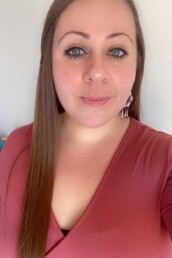
What brought you to COTS?
I was previously homeless and stayed in transitional housing with my child. I have always held shelters in my heart and have a passion for helping people. COTS has always been known as a great shelter, and they have many important programs that support our most vulnerable population. When I came for my interview, I knew it was going to be the right fit.
Tell us about your previous experience.
I grew up in low-income housing projects with all different types of people. I have always been drawn to helping people and can relate to many different situations. I decided to get my bachelor’s degree in Criminal Justice and Criminology as well as my master’s degree in Public Administration. I volunteered to advocate for childcare and early education and support low-income parents. I was on the Board of Directors at NAMI (National Alliance on Mental Illness) and a Warmline Specialist for a year.
Tell us about a typical day in the life of a bilingual care manager.
My day-to-day care management load varies. When I see my monolingual Spanish-speaking clients, I am usually working with them to try and find employment/income and/or citizenship paperwork. Working as a bilingual care manager, I am spending more time with clients, giving them rides to the doctor’s office, providing verbal translation, and calling Partnership for rides. I also make many types of appointments and translate all paperwork and texts that clients receive in English. I focus a lot on job searches where the employer does not mention applicants needing a social security number.
What are some of the biggest challenges facing your Spanish-speaking clients?
It can be very challenging to navigate employment options for my clients because some are undocumented. They struggle to find an employer that will hire them without requiring a social security number verification.
Most of my Spanish-speaking clients struggle to find employment and because of their citizenship status, they cannot receive government assistance, such as SNAP, GA, or SSI. These clients typically have to find an under-the-table type of job and still pay for a room to rent, as they usually cannot be referred to housing due to their lack of social security numbers. While it is a struggle to find them housing, I also make sure they have adequate resources by making sure our documents here at COTS are in Spanish. If they are not, I translate them.
Donald's Story
Before COTS, Donald was living a successful life with a good job. But as he said, “everything fell apart, and then I fell apart.” His relationship with his children wasn’t in the best place. He hadn’t spoken to one son in almost two years. His daughter lived out of the state.
When COVID hit, Donald moved in with his sister, Stella, to be her full-time caretaker. Sadly, Stella’s health continued to decline and her son stepped in to move her to a care facility and Donald was told to move out. But he had no place to go.
One of his sons told him he had to go to COTS. It was near his work, so Donald could visit, and a stay at COTS would give him time to find housing.
It was a hard choice, but he decided to go to COTS. Soon into his stay, he met with volunteers and staff in our Red Tape Club to get the assistance he needed to find housing.
Donald learned he was eligible for social security. So, he secured his own ride to the Social Security Administration to get his card and secure his benefits. He found out he was able to work and receive benefits, so he set his sights on getting a job.
Lucky’s grocery store is a close walk from COTS. He spoke to a manager about getting a job and was told to apply online. “I don’t know how to use computers”, said Donald, so a Red Tape Club volunteer helped him fill out the online application and was hired immediately.
Donald had a strong drive to get his life together and get his family back. That drive and focus became a real inspiration for several clients. “My old bunkie told me when I come here and see you it makes me know that I can do it that, I can that I can survive.” Donald was a great listener for fellow residents, many of whom just needed a listening ear, but he was also quick to tell them that they needed to put in the effort if they wanted to see a change in their life.
Eventually, Donald was able to secure housing right before the holiday season. He hosted Thanksgiving for some of his friends he’d made at COTS. As they sat down to eat, one of his friends started to cry – it was his first time having a family style Thanksgiving dinner.
Then, his wish to reconnect with his family came true. His two sons came to his new place on Christmas Day. He now has a daughter-in-law and a grandson in his life. His kids told him, “We’re proud of you dad, we’ve got you back.” He’s reconnected with his ex-wife, who recently helped get him to a doctor’s appointment.
Today he’ll tell people, “Thank God for COTS.”. He tells his boys, “If it wasn’t for COTS, I wouldn’t have you back in my life.” He’s grateful that our founders had the vision to create COTS, so there would be a place in our community where individuals and families could get help.
He recalls when his son first told him to go to COTS. “I didn’t want to go there, I told him please don’t do this to me, but it saved my life.”
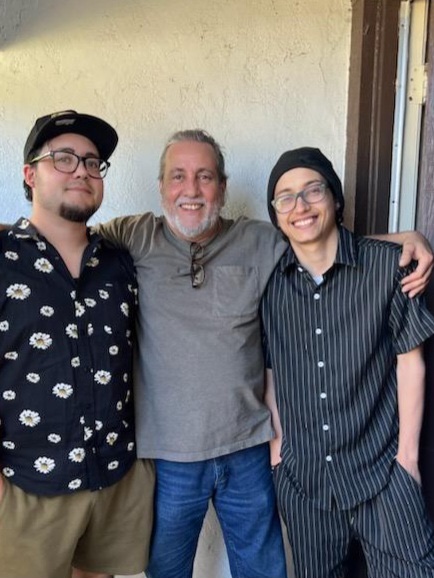
The COTS Collective: September 2023

“ I am so grateful to have such well thought out healthy meals, I couldn’t heal properly without them.”
– Linda Guajardo
Mission Moment: Mary’s Table Needs Your Help!
Since 1988, COTS has served our community as one of the largest homelessness services providers in Sonoma County. Did you know that COTS also serves anyone in the community experiencing food insecurity? Every day, COTS prepares hot lunches and dinners for anyone in Sonoma County who needs a warm meal. This year, COTS will prepare and serve more than 90,000 hot meals to our neighbors throughout Sonoma County, ensuring everyone has access to hot, nutritious food every day of the year.
During the height of the pandemic, our kitchen operations had to quickly pivot to keep our community members safe. While preparing and serving individually packaged meals increased the workload on our staff, COTS was happy to make this shift to provide a safer dining experience for any individual or family needing meals. This shift also helped COTS provide a safe place for our clients, including families, those in transitional shelter, and those in our emergency shelter right here at the Mary Isaak Center.
Between 2020 and 2023, the COTS kitchen has increased the number of hot meals served to our community by more than 30%. This increase in need demonstrates the effects that the pandemic and historic inflation had on our neighbors in Sonoma County. This incredible increase in need has also strained COTS’ capacity to serve everyone in need, and we could use your help!
Mary’s Table is one of the most successful—and one of the busiest! —programs here at COTS. Without community support, COTS could never serve over 90,000 meals annually. If you are interested in helping COTS continue eliminating food insecurity in Petaluma and throughout Sonoma County, you can donate at our website at www.cots.org. If you are interested in volunteering at Mary’s Table, please reach out to Erin Krueger at [email protected]. COTS appreciates all support from our community, and thanks you for your interest in helping Mary’s Table!
Until next time,
Chris Cabral

Sincerely,

Chris Cabral, CEO
“I love the fact that the kitchen always serves fruit, vegetables, and salad along with the main meal as a complete meal is crucial for my healing process.”
– Ahmed Shaheed
“ The kitchen provides great meals, and atmosphere, that creates the opportunity for a whole healing experience.”
– Florence Cocoran
” Chef, and her team, play a crucial part in the healing needs of my clients, the meals that are created play a very important part in recovery process of our clients. I would [be] remiss not to mention that the meals created are tasty too.”
-Pat Higgins
Ensuring Stability and Hope: How COTS Supports Children’s Education

In a world of constant change and uncertainty, education stands as a beacon of hope and opportunity. For children experiencing homelessness, the importance of staying in school cannot be overstated.
Amidst the challenges and hardships that come with homelessness, maintaining a consistent education can provide a lifeline to stability, empowerment, and a brighter future. That’s why, at COTS, Care Manager Wendy Lindberg works so diligently to support children’s education.
When a new family moves in to KFFS, one of the priorities is their children’s education. If the family is from out of town, Wendy will register their children in the Petaluma School District. If the family is local and prefers to stay at their home school, she reaches out to that school district to start work on a transportation plan.
The McKinney Vento Act requires that school districts provide transportation for students experiencing homelessness and that may be in the form of a bus ride, gas cards or even a driving service like Uber. It can take weeks for a plan to come into place, so in the meantime Wendy supports our parents by assisting with school drop off and pick up.
Wendy also helps our KFFS families navigate the difficult terrain of getting an IEP (Individual Education Plan) for children. She helps families gather documentation, brings them to appointments and acts as an advocate when needed. She shared how proud she is of the families both at currently at KFFS and those recently housed who set up IEPs with her assistance and are continuing them.
We’re so grateful to Wendy for the incredible work she does supporting our families. By prioritizing children’s education, COTS offers our families stability and hope.
By investing in COTS, you are investing in the education of children, we are investing in a future where potential knows no bounds and where the cycle of homelessness can be broken, one child at a time. We invite you to support this life changing work
Volunteers Make A Difference!
While we believe that Wendy is super woman, KFFS is also fortunate to have community support from volunteers who go above and beyond for our families. We have volunteers who provide after school homework assistance and organized-play. It’s an incredible opportunity for community members to support our families and ensure that children stay on top of their schoolwork. Community groups like the Petaluma Valley Rotary Club and Active 20/30 Club also provide material needs to our families. This August both groups helped provide backpacks, school supplies, school clothes and more for the families at KFFS.
This winter, more groups will come together to support our families over the Holidays. To learn more about how your or your community groups can get involved, email [email protected].
“Recently, a past client called to share with me the progress they were making with their child’s speech therapy, thanks to their IEP. It’s so gratifying to see our families doing so well.” Wendy Lindberg
Ashley's Story
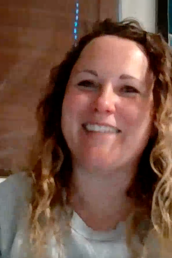
At COTS, we love to celebrate our teammates’ successes. So when HUD-PSH (Permanent Supportive Housing) Care Manager Ashley Lovejoy got into her first choice nursing program, the whole team erupted in a series of congratulatory emails.
“I’ve always naturally been drawn to medicine,” she says. In spite of this, the journey to nursing school has not been simple, or easy.
“I grew up on and off homeless my whole life, like my whole childhood,” she says. “When I was in high school, my family actually lived in a COTS house. So that’s how I knew about COTS, was my experience with them when I was young.
“I had a great experience with COTS and the caseworkers. They were very encouraging of me, [even when] my mom was encouraging me to drop out of high school when I had a 4.0.”
In spite of her mother’s drug addiction, and with the support of her COTS case manager, Ashley finished high school. She then attempted Sonoma State, but dropped out after taking on too many advanced classes. She got married, then divorced, worked in England and Denmark, and is now a single mom of four boys.
After her divorce, she and her kids moved back to the States. “Within a couple of weeks of moving back here, I went back to school at the JC. And in a couple of years, I went back to Sonoma State and got my Bachelor’s in Sociology.“
Last May, her journey brought her back to COTS, when she joined the team as our HUD-PSH Care Manager. “I told everyone coming in that I wanted to work for COTS because of my history with COTS, and because I wanted to make a difference,” she says.
Prior to working at COTS, Ashley’s love of children had always drawn her to pediatrics. But her experience working with clients in the Permanent Supportive Housing program quickly changed all that. “After working for COTS and then working with the clients that I have, building that relationship, I’ve decided I’m specializing in adult geriatrics now, because I see such a need,” she says.
“I’ve seen with my clients, how fearful a lot of them are. [A lot of our clients are] very hesitant [to seek medical care] because they feel judged. I have one who, once he left the Mary Isaac Center, he refused to see a doctor. Any time he saw one, [he’d say] ‘They don’t care about me.’”
Not willing to give up, Ashley approached Nurse Annie Nicols, who gave her a personal recommendation for a nurse practitioner, and the client agreed to go. “Now he’s been getting medical care for his chronic conditions because of that trust he has in her,” Ashley says. “That’s part of what motivated me to go back [to school for nursing].”
For Ashley, having the Petaluma Health Center on campus has been invaluable in helping her clients. While she doesn’t know where she’ll end up after nursing school, “I would love to go back and work with the Petaluma Health Center,” she says. “My kids have always gone there, and I love the fact that they work with COTS.”
Ashley’s lived experience with homelessness gives her a valuable connection to her clients, one she hopes she’ll be able to bring with her into her nursing practice. “I can connect, and I’m able to build such trust with all of my clients now,” she says. “I’m in a unique position where if I were to come back and work with this population, I feel like I’d be able to hopefully be someone that they felt they could trust. So that is kind of my long term goal.”
When asked what her favorite thing about her job at COTS is, she said, “I love the people. Every every one of our clients have such interesting and unique backgrounds. I’ve got one that I’ve helped enroll in school, and he’s back to school for the first time in like 45-50 years, and he’s getting an Associate’s Degree. I have another one that is going to go to school to become a minister, that’s his passion. It’s really amazing to see.”
We are grateful to have Ashley on our team for the rest of her time leading up to nursing school, and when it’s time, we wish her luck on her next adventure.
Suzy's Story
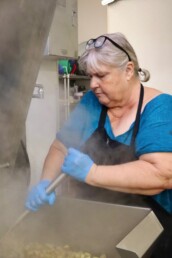
Suzy’s Story
Suzy lived a regular life. She had a job, a car, and an apartment that she shared with her son. But after a medical event left her son with a traumatic brain injury and unable to work, it became harder to stay housed.
Eventually, Suzy and her son became homeless. “I’m from Petaluma, so I’ve always known about COTS” Suzy said, but it was a worker at Petaluma Health Center that encouraged the family to apply to COTS. While her son began his journey to sobriety at COTS, Suzy hid her addiction to alcohol.
Her alcoholism got the best of her, and Suzy had to leave COTS. “I lived in a tent under an overpass for a month. I was still drinking and was so dehydrated, I had hallucinations. I had to go to the hospital. I was so sick and weak.” Suzy was discharged and her son started bringing her the to-go meals COTS offers and eventually she started coming back to COTS for meals herself, applied to live at the COTS shelter again, and she made a commitment to sobriety.
Suzy met our Head Chef, Janin, who listened to her story and encouraged Suzy to start volunteering in the kitchen. That’s when things began to change. Little by little, she regained her strength and sense of self.
“They took care of me, I got stronger every day, so I could do more and more. And it became a family. And then it reached the point where I was doing it [volunteering] because I wanted to, not because it was air conditioned. I was doing it because there’s such camaraderie in the kitchen. I had lost myself, and being here with people who care about you, and where you are giving back was, it changed my life. It allowed me a place to kind of heal and find myself. So, it’s a rescue story.”
Today, Suzy is celebrating over three months of sobriety. She credits the staff at COTS for making her feel supported and cared for. When she’s not preparing food in the kitchen, she’s helping pass out dinner. Suzy sees individuals she met while living in an encampment and encourages them to come inside. She wants others to know that even when they aren’t sure about COTS, or when the journey back to housing feels insurmountable, that they should try. “They’ve just forgotten that they can. Because I, I kind of did. I forgot that I could do all this. I can, even though I [was] lost. This says that it has nothing to do with my future. Again, I can set that aside and say from here, I can go forward.”
Housing is Suzy’s next step, and she is hoping to stay in Petaluma so that she can continue to volunteer. “I want be a core volunteer, that’s how much this place means to me.”
COTS is so grateful to the staff who didn’t give up on Suzy and who are continuing to support her in her journey back to housing. Thank you to the many supporters who made this work possible for Suzy and so many others.
The COTS Collective: July 2023


Beyond Shelter: Pets at People’s Village
COTS is proud to offer various innovative programs to best help our clients every day. Each COTS client has a unique story, and all our programs are designed to be flexible in meeting the needs of those we serve. Programs like People’s Village provide interim housing to people experiencing homelessness—offering a safe and secure place for individuals to focus on improving their well-being and self-sufficiency.
Having pets can be a beacon of hope for those experiencing homelessness and People’s Village is one of the few temporary housing options available which allows pets, eliminating a barrier often faced by people experiencing homelessness.
Read on to learn more about our client Brandon, and his dog Izzy, in our Mission Moment.
Until next time,
Chris Cabral
Mission Moment—Who Rescued Who?
Brandon first came to COTS in 2017, but the challenges in his life kept him from permanent housing. Then in 2023, when he was living at a camp in Cloverdale, COTS Outreach staff shared with him about an opportunity to live at People’s Village.
So, he decided to give it a try. Since animals are allowed at People’s Village, he knew he could work on finding housing, his recovery and rescue a puppy living at the encampment. Brandon knew he wanted to save one of the pups, but it turns out, she saved him too.
Brandon came to COTS using opiates but knew he couldn’t care for a dog in his current state. He detoxed and gained his sobriety. Then went back to save Izzy, a special pup with two spots on her back shaped like hearts. She was just three weeks old. Brandon bottle-fed her and cared for her around the clock. She kept him busy and focused, two things needed to keep him sober.
“[She’s] kept me from going back out and doing stuff I shouldn’t be doing. It’s definitely helped me through those moments when you don’t really know who to talk to you, but these dogs are there. You know, there’s no judgment that comes from her either. That’s the greatest part.”
Brandon worked with his Care Manager, Stacie Questioni, on his individual action plan and Client Enrichment Services Manager, Eileen Morris helped Brandon, an army veteran, secure a housing voucher through Veteran’s Affairs. “Eileen has been a huge help. The biggest help when it comes to housing… She’s a rock star.”
Today, Brandon is continuing his search for housing and working hard at taking care of Izzy. He’s an excellent dog parent, keeping an active five month old puppy busy and well-trained.
Brandon’s ready for the stability of permanent housing, a home for him and Izzy. “My hope is to just keep it [housing], I’m done with being back on the streets.” We are so proud of the work Brandon is doing to find housing and can’t wait for the day when he has a home to call his own.
Thank you for your support of innovative programs like People’s Village and our Client Enrichment Program that create opportunities for clients like Brandon. We are so grateful of your support of our vision to create a community where everyone has a place to call home.


Sincerely,

Chris Cabral, CEO
Brandon and Izzy
Who Rescued Who?
Brandon first came to COTS in 2017, but the challenges in his life kept him from permanent housing. Then in 2023, when he was living at a camp in Cloverdale, COTS Outreach staff shared with him about an opportunity to live at People’s Village.
So, he decided to give it a try. Since animals are allowed at People’s Village, he knew he could work on finding housing, his recovery and rescue a puppy living at the encampment. Brandon knew he wanted to save one of the pups, but it turns out, she saved him too.
Brandon came to COTS using opiates but knew he couldn’t care for a dog in his current state. He detoxed and gained his sobriety. Then went back to save Izzy, a special pup with two spots on her back shaped like hearts. She was just three weeks old. Brandon bottle-fed her and cared for her around the clock. She kept him busy and focused, two things needed to keep him sober.
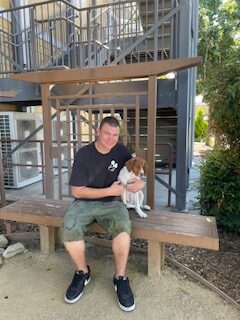 “[She’s] kept me from going back out and doing stuff I shouldn’t be doing. It’s definitely helped me through those moments when you don’t really know who to talk to you, but these dogs are there. You know, there’s no judgment that comes from her either. That’s the greatest part.”
“[She’s] kept me from going back out and doing stuff I shouldn’t be doing. It’s definitely helped me through those moments when you don’t really know who to talk to you, but these dogs are there. You know, there’s no judgment that comes from her either. That’s the greatest part.”
Brandon worked with his Care Manager, Stacie Questioni, on his individual action plan and Client Enrichment Services Manager, Eileen Morris helped Brandon, an army veteran, secure a housing voucher through Veteran’s Affairs. “Eileen has been a huge help. The biggest help when it comes to housing… She’s a rock star.”
Today, Brandon is continuing his search for housing and working hard at taking care of Izzy. He’s an excellent dog parent, keeping an active five month old puppy busy and well-trained.
Brandon’s ready for the stability of permanent housing, a home for him and Izzy. “My hope is to just keep it [housing], I’m done with being back on the streets.” We are so proud of the work Brandon is doing to find housing and can’t wait for the day when he has a home to call his own.
Thank you for your support of innovative programs like People’s Village and our Client Enrichment Program that create opportunities for clients like Brandon. We are so grateful of your support of our vision to create a community where everyone has a place to call home.
STORY UPDATE: November 2023
This month, Brandon and Izzy have moved out of COTS People’s Village housing and into Windsor Veteran’s Village, a supportive, veteran-focused housing community. We are so proud of all your hard work, Brandon!
A shout out to Stacie Questoni, Nora Vetter, Randy Clay, and all of our teammembers at COTS who worked together with Brandon to see him through to housing of his own!
Pictured below is Brandon (left) and Stacie Questoni, COTS’ People’s Village Services Manager, (right) in front of Brandon’s new residence.
